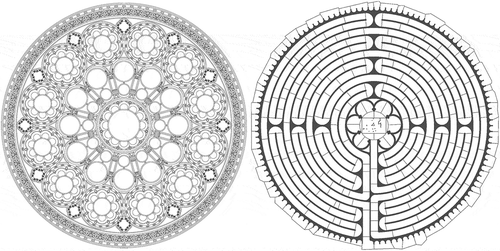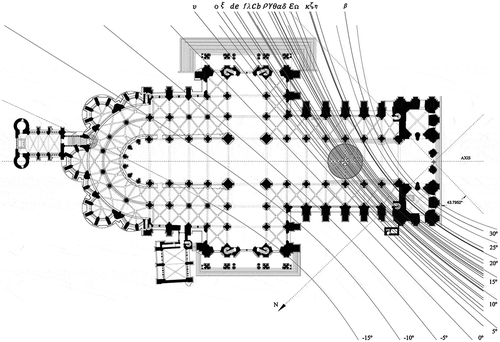Abstract
We present a geometric-astronomical correlation between the rose window on the main façade and the labyrinth of Chartres cathedral. This correlation existed throughout the building’s construction—epoch J1200–. Since classical mythology relates the labyrinth to the Taurus constellation, we will project the daily orbits of the stars of this constellation through the center of the rose window, thus finding their paths on the cathedral’s floor plan. We will show that Elthor—“the bull” at the center of the constellation—was projected on the center of the labyrinth. We will consider possible mythological motivations to purposely create this alignment.
PUBLIC INTEREST STATEMENT
Nobody knows for sure why a labyrinth was built on the floor plan of Chartres cathedral, or why it was positioned at that precise location. This paper shows that a geometric-astronomical alignment existed during the period when Chartres cathedral was built, 1200 CE. We show the existence of the alignment Elthor, where Elthor is the central star of the Taurus constellation,
is the center of the cathedral’s main rose window, and
is the center of the labyrinth. At the end of the paper, we suggest a possible mythological motivation. Despite this, it is not our intention to claim or deny in this paper that the medieval master builders intentionally took this alignment into account when designing the building. We simply intend to show the geometric existence of such an alignment.
1. Introduction
It is hard to say when drawings and engravings of labyrinths began to appear or which civilization was the first to use them. The earliest known depictions date from the late Neolithic period and the early Bronze Age (approximately in the second millennium B.C.) (Reed, Citation1992). Labyrinths began to be used in churches and cathedrals during the Roman period. The first known labyrinth within a Christian context was built in Algeria in the Basilica of Reparatus in Orleansville (324 A.D.) (Fawcett, Citation2001). At first, labyrinths appeared mainly in manuscripts. By the twelfth century, pavement labyrinths began to be included in the design of many cathedrals and churches in Italy, and during the thirteenth century they spread to France, where very good examples are to be found. The best known medieval labyrinth is undoubtedly the one in Chartres cathedral.
Medieval labyrinths, specially the one in Chartres cathedral, have raised many questions and have been attributed many uses, such as: penitential use by devout Christians, who would walk on their knees as a substitute for the long and arduous pilgrimage to Jerusalem; or liturgic use on Easter Day (Wright, Citation2001). According to some theories, the labyrinth (encircled by an outer ring of 122 lunations, 28 in each quadrant) might have been used as a lunar calendar to determine the date of Easter each year (Artress, Citation1995; Critchlow, Carroll, & Vaughan, Citation1975) In this paper we show a geometric-astronomical superposition correlating a particular and special star of the constellation with the center of the labyrinth.
These two architectural and historical elements—the labyrinth and the rose window (Figures , )—have been formally associated on several occasions in order to provide an answer to the very existence of the labyrinth; however, contrary to our research, these associations only considers its dimensions and location (Critchlow et al., Citation1975; Laporte & Odette, Citation1997; Tomasini, Citation2015). The architectural uniqueness of the main rose window is due to its impressive size, its constructive complexity and its important role in the composition of the main façade. All these qualities are the reasons why the rose window has been the focus of many research studies; for instance the geometric analysis of its texture or construction (Lluís i Ginovart, Samper, Herrera, Costa, & Coll, Citation2016; Samper & Herrera, Citation2016), or the study of the solar rays entering the cathedral (Heilbron, Citation2001). However, this rose window had never been examined as an astronomical instrument until 2016, when Seguí et al. wrote a paper where the star orbits of the catasterism of ancient virgin goddesses are projected through the rose window and correlated with the general architectural structure of the cathedral (Seguí, Samper, & Herrera, Citation2016). In the present paper, we follow a similar methodology to that earlier work and we study in depth the special relationship with the labyrinth.
Figure 2. Photographs taken by the Authors, showing the two architectural elements considered in this paper.
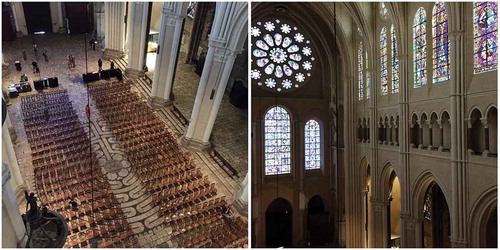
1.1. Adopted methodology
We will consider the main rose window and we will use its center to project the astronomical daily circular orbits of certain stars, thus finding their paths on the cathedral’s floor plan. To put it simply, this paper is based on projecting star orbits onto the floor plan of Chartres cathedral through its main rose window (Figure ). This process of projecting star orbits through the main rose window of the Chartres Cathedral is not an idea unique to us, nor is it attributable only to the Chartres Cathedral; it is an ancient process that was already used in some classical buildings. A relevant example is the Clementine Gnomon in the Basilica of Santa Maria degli Angeli in Rome (Catamo & Lucarini, Citation2002; Sigismondi, Citation2011). Pope Clement XI commissioned the astronomer and archaeologist Francesco Bianchini to create this gnomon. This gnomon is an ingenious device that allows a person to see the star orbits during the day and not only by night, projecting these daily orbits on the Basilica’s floor. In fact, the Clementine Gnomon is a sundial synchronized with sidereal time. Using this sundial, it is possible to observe the meridian transits of the sun and the stars Sirius, Polaris and Arcturus simultaneously as ellipse and hyperbola arcs on the basilica’s floor. These projections were made through holes in the ceiling and through a hole in the centre of the pope’s coat of arms placed on a wall of the basilica at a height of 20.34 m. In this paper, we repeat the process with Chartres Cathedral and its rose window, numerically calculating the orbits of the stars involved.
Figure 3. Diagram of the alignment between the rose window of the main facade, the labyrinth and the Taurus constellation. The representation of the constellation is publicly offered by the International Astronomical Union (www.iau.org).
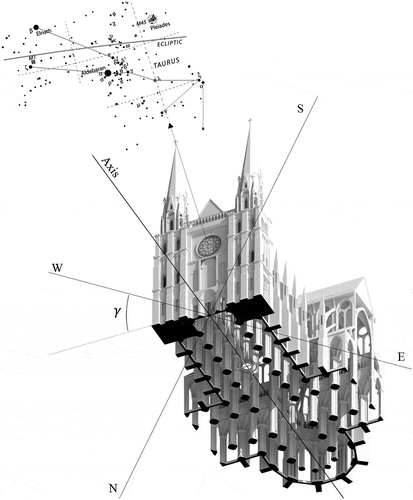
More specifically, we will follow the steps below: First, in subsection 4.1 we will show the geometric and architectural parameters. Second, in subsection 4.2 we will show the astronomical positions of the stars making up the Taurus Constellation during the period when Chartres cathedral was built. These positions are calculated by means of well-known astronomical algorythms (we ourselves have created the necessary calculation software). Third, we will calculate the projections of the daily orbits of the stars through the center of the main rose window, and we will obtain the corresponding paths on the floor plan of Chartres cathedral. In other words, we will calculate the positions (on the floor plan of Chartres cathedral) from which each star could be seen through the center of the main rose window at that time. These paths will be shown in subsection 5.1. Lastly, also in subsection 5.1, we will show the most relevant results which will lead to the conclusions in section 6.
2. Brief description of the labyrinth in chartres cathedral
Nobody knows for sure when the labyrinth was built, even though several theories exist. The research by John James (James, Citation1977, Citation1990) and Craig Wright (Wright, Citation2001) suggests that the labyrinth was built in the early thirteenth century—during the early period of construction of the cathedral, which mostly was built between 1194 and 1226 (Figure )–.
The labyrinth is defined by an ellipse whose major axis and minor axis have a length of and
, respectively. The center
of the labyrinth is located on the longitudinal axis of the cathedral and it is
away from the entrance on the main façade. The labyrinth’s path winds into a central circle which is concentric to the ellipse and measures
in diameter. According to John James (James, Citation1990), the pathway is
long and it is
wide on average.
The innermost circle formerly contained a metallic plaque which bore a representation of the combat between Theseus and the Minotaur, but we have no plan or diagram of the layout of its design; the plaque was removed in 1792 (Connolly, Citation2005; Villete Citation1994; Wright, Citation2001).
3. Summary of taurus mythology
Many labyrinths built in the Western world were inspired by the Greek myth of Theseus and the Minotaur. To sum up the story: of all men who had ever entered the labyrinth where Asterion the Minotaur—son of Pasiphaë—had been confined by King Minos of Crete, only Theseus, prince of Atens, was able to escape with his life thanks to the help of Ariadne—daughter of Minos—and the famous ball of thread. Later on, labyrinths became popular throughout the Roman Empire as protective and decorative symbols, and they were linked to the world of the dead, as can be seen in Virgil’s Aeneid.
Catasterisms (i.e., the transformation of heroes, gods or mythological beings into stars, celestial objects or star patterns on the celestial sphere) were common praxis in several ancient civilizations. For example, in Greek mythology, Taurus is the bull-form Zeus took in order to win Europa, a mythical Phoenician princess who had three sons: Minos (the legendary King of Crete), Rhadamanthus and Sarpedon (Eratosthenes & Schaubach, Citation1795; Allen, Citation1889).
In the Middle Ages, the Western world only recognized the 48 constellations listed in Ptolemy’s Almagest (85–165 CE) (Peters & Knobel, Citation1915). Amongst them, the Taurus constellation is made up by 142 visible stars—visual magnitude –, including Aldebaran
, Elnath
and Ushakaron
. However, Elthor
is the only star which is attributed the name of the whole constellation (its name is Arabic and means “the bull”). Elthor is the fifth brightest of the entire constellation. Bayer mentions it in his Tabvla Vigesima Tertia. TAVRVS. from Uranometria with the latin name “inpectore”, which means “on the chest” (this star is located at the center of the bull’s chest, see (Allen, Citation1889; Bayer, Citation1603) http://lhldigital.lindahall.org/cdm/ref/collection/astro_atlas/id/118). Also in Tabvla Vigesima Tertia from Uranometria we find the rest of the most important stars of Taurus as the star Aldebaran (its name is Arabic and means “the follower” because it rises soon after the Pleiades), which makes the bull’s eye, and the star Ushakaron (its name is Akkadian for “the avenger”), corresponding to the bull’s legs, etc. (Figure ).
On the basis of the abovementioned mythology, we will determine if there is an astronomical relationship between the Taurus constellation and the labyrinth in Chartres cathedral. We will use the center of the main rose window as a projection center for the celestial objects. More precisely: we will project the Taurus constellation on the floor plan of Chartres cathedral through its main rose window.
4. Projection of the star daily orbits of Taurus constellation on the floor plan of Chartres cathedral through its main rose window
4.1. Parameters which are intrinsic to chartres cathedral
In order to calculate the projection of the star daily orbits on the floor plan of Chartres cathedral through its main rose window, we first need to determine the architectural parameters of the building , shown in Table and Figure , . These parameters are explained next.
Table 1. Parameters which are intrinsic to Chartres cathedral
Despite all the events that took place throughout the nearly 36 years of construction, the cathedral’s longitude , latitude
and orientation
(the angle formed between the parallel where the cathedral lies and the ground line of the main façade, with west to north being the positive orientation) were the constants which determined the building’s design.
As for the main rose window, we consider the height of its center point (through which we will project the star daily orbits) with respect to the cathedral’s floor level, and the horizontal deviation
from the central axis of the cathedral. This shift to the left
is shown in Table and can be seen in the elevation view (Figure ).
Figure 5. Tabvla Vigesima Tertia.TAVRVS. from Uranometria, by Bayer. Universitätsbibliothek Heidelberg. http://digi.ub.uni-heidelberg.de/diglit/bayer1648/0076.
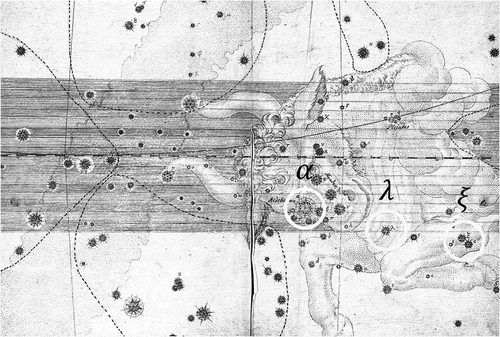
It must be born in mind that the cathedral’s floor is not perfectly horizontal, but rises in height towards the ambulatory. Ignoring this topographic feature could significantly alter all results: the difference in elevation between the cathedral’s entrance and the center of the labyrinth is 60 centimeters (
; see Figure , and also Table ).
The location parameters have been obtained through GPS coordinates, and the distance parameters have been measured in the field using a laser meter (Leica DISTOTM D510). All measurements have been subsequently checked with a graphic survey (floor plan, elevation and cross-section) obtained from the Library of the Austrian Federal Ministry for Education, Arts and Culture, and from Scanproject “Heritage Monuments Board of Austria”. All parameters considered are shown in Figure , as well as Table .
4.2. Astronomical epoch J1200
Next, in order to determine the projections of the daily orbits we must decide in which astronomical epoch we will make our calculations.
The positions of the stars on the celestial sphere are changing constantly as a result of the Earth’s axis precessional motion (precession of equinoxes) and each star’s proper movement. The combined variation caused by both movements is an effect that must be taken into account. Therefore, the astronomical positions of the stars do indeed vary throughout 800 years (the time elapsed since Chartres cathedral was built).
As for the star positions, there is little difference between the present epoch and the reference epoch J2000, that is, the epoch of Julian day JD(2,451,545.0)–. However, as a result of the Earth’s precessional motion and each star’s proper motion, we must consider the astronomical epoch J1200 (close to the period when Chartres cathedral was built), that is, the epoch of Julian day JD(2,159,345.0). The correlation shown in this paper does not happen only one day; given the slow Earth’s precessional motion and the stars’ proper movement, this correlation occurs every day of every year during the construction of the cathedral.
Readers may turn to any book on astronomy (Martín, Citation1990; Meeus, Citation1991) for definitions and calculations of: CE Gregorian year, CE and BCE Julian year and Julian day JD(#) according to the time measurement system proposed by Joseph Scaliger.
In order to make the relevant calculations—taking the celestial right ascension and declination coordinates of any star at astronomical epoch J2000 and obtaining their corresponding celestial coordinates at astronomical epoch J1200—we have considered the mean equinox—the Earth’s axis precessional motion and each star’s proper motion–, and we have used rigorous the astronomical algorithms stated in (Meeus, Citation1991) and the data contained in the SIMBAD database (http://simbad.u-strasbg.fr/simbad). The results, for the 20 brightest stars in Taurus, are shown in Table .
Table 2. Celestial coordinates of the main stars in Taurus constellation. We highlight the star Elthor, which is the fifth brightest of the entire constellation
5. Projection results
5.1. Daily astronomical orbits and daily path trajectories on the floor of the cathedral
Each of the stars in the Taurus constellation moves in a daily circular orbit on the celestial sphere. Next, with all parameters considered
(shown in Table ), the daily orbits
of the 20 brightest stars in the Taurus constellation (shown in Table ) will be projected on the platform of Chartres cathedral through the center of the rose window
. With these projections of the orbits
, we will obtain the path
of each star on the floor plan of the cathedral. In order to plot the paths
at astronomical epoch J1200.0 having total control of the graphic process, we have designed a software application. We have entered all values in CAD vector format and precisely redrawn the floor plan of Chartres cathedral. The result is shown in Figure .
We emphasise that many paths of the stars in this constellation pass over the surface of the labyrinth. This includes important stars such as Aldebaran (
), Elthor (
) and Ushakaron (
). The entire labyrinth is included within the area covered by the star orbits.
Strikingly, the path of Elthor cuts through the center
of the labyrinth—according to our calculations, the difference between
and
is only 4.60 centimeters. In addition, as we explain in Section 5.2 and we show in Figure , the difference became of 0.00 cm in the early years of the construction of the cathedral, i.e. this coincidence was observed accurately during the 32 years of the construction of the cathedral. In short, every day, in the astronomical epoch J1200, existed the astronomical-architectural-geometric alignment between: Elthor,
and
.
5.2. The correlation existed every day throughout the period of construction of the building, when the labyrinth was designed on the floor of the cathedral
In the previous sub-section we have shown the alignment between Elthor with two architectural elements (). We have calculated this alignment at the Julian day JD(2,159,345.0) determined by the astronomical epoch J1200.0. The Julian day JD(2,159,345.0) is the number assigned at noon Greenwich on December 19 of the Julian year 1199 CE. The labyrinth was built during the early period of construction of the cathedral; it was built between 1194 and 1226 (Figure )–. We recalculate the path
for the Julian day JD(2,157,165.0), i.e. at noon Greenwich on January 1 of the Julian year 1194 CE; we call this daily path
. Also, we recalculate the path
for the Julian day JD(2,169,219.0), i.e. at noon Greenwich on December 31 of the Julian year 1226 CE; we call this daily path
. The astronomical parameters of these paths are shown in Table .
Table 3. Celestial coordinates of Elthor during the construction of Chartres cathedral
We find that the difference between and
was 6.81 centimeters. Also, we find that the difference between
and
was 5.31 centimeters. Moreover, we find that the center
of the labyrinth was between the two paths, then the difference came to be zero. Figure shows the detail of the three daily paths
,
,
. These differences show that the alignment Elthor
existed throughout the period of the construction.
6. Conclusions
As we have stated before, the innermost circle of the labyrinth formerly contained a plaque which bore a representation of the combat between Theseus and the Minotaur (the rivets that held it in place still can be seen at the central panel). The labyrinth is the classic representation of the bull (the Cretan labyrinth at Knossos). This is why we have considered—of the 48 constellations mentioned in the Almagest of Ptolemy and recognized in the Middle Ages by the Western world—the Taurus constellation and its 142 visible stars—visual magnitude –. In this work we have projected the daily orbits
of the 20 brightest stars in the Taurus constellation (shown in Table ) on the platform of Chartres cathedral through the center of the main rose window
. With these projections of the daily orbits
, we have obtained the daily path
of each star on the floor plan of the cathedral at the astronomical epoch J1200.0—the construction epoch of the cathedral–. The results, described in the previous section, are shown in Figure and in detail in Figure .
Figure 8. Daily paths ,
and
at J1200. In the centre is marked daily paths
of the astronomical epochs J1194 and J1226.
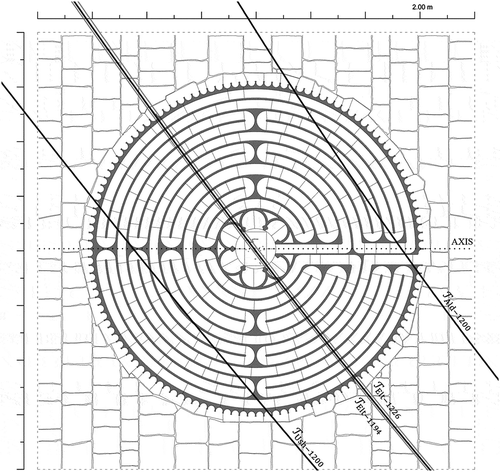
With the calculations we can say that many paths of the stars in this constellation crossed over the surface of the labyrinth. This included important stars such as Aldebaran (
), Elthor (
) and Ushakaron (
). And we can say that the entire labyrinth was included within the area covered by all the star orbits (Figure ). Moreover, we can say that the path
of Elthor crossed the center
of the labyrinth, i.e. during the period of construction of the cathedral, every day existed the alignment between: Elthor,
and
.
6.1. About the motivation to purposely create this alignment
We have just demonstrated the existence of an alignment between: Elthor, and
.
A possible motivation has been already mentioned at the end of Section 2 and also at the beginning of these Conclusions: it is the myth of Theseus and the Minotaur at the Cretan labyrinth at Knossos. Therefore, establishing a relationship between the Taurus constellation and the labyrinth should come as no surprise, and in fact the innermost circle of the labyrinth formerly contained a plaque which bore a representation of this myth. And as mentioned in Section 3, Elthor is the anatomical center of Taurus—the heart in the bull’s chest—and its geometric central position can be seen in the classical depiction provided by Bayer. Therefore, the concordance between the center of the Taurus constellation—Elthor—and the center of the labyrinth should come as little surprise.
In our view, the mythological motivation provides indications to believe that the cathedral’s architect could have taken the alignment into account when placing the labyrinth.
Nonetheless, it is not our intention to claim or deny in this paper that the medieval master builders intentionally took this alignment into account when designing the building, but we do show the geometric existence of such an alignment.
Additional information
Funding
Notes on contributors
Blas Herrera
Blas Herrera is Geometer who obtained his D.Sc. in Mathematics at the University Autònoma of Barcelona in 1994. Presently, he is a full professor of Applied Mathematics at the University Rovira i Virgili of Tarragona. His main fields of research interest are: Classical and Differential Geometry, and the application of Geometry to Architecture, Fluid Mechanics and Engineering.
Albert Samper
Albert Samper is an Architect who obtained his Ph.D. in Architecture at the University Rovira i Virgili of Tarragona in 2014. Presently, he is an assistant professor of Architecture at the same university and his main fields of interest are: Fractal Geometry and the application of Geometry to Architecture.
Joan M. Seguí
Joan M. Seguí who obtained his Ph.D. in Architecture at the University Rovira i Virgili of Tarragona in 2017. His main fields of interest are: Astronomy, Gothic Cathedrals and the application of Geometry to Architecture.
References
- Allen, R. H. (1889). Star Names: Their lore and meaning. United States of America: Dover Publications, Inc.
- Artress, L. (1995). Walking a sacred path: Rediscovering the labyrinth as a spiritual tool. New York: Riverhead Books.
- Bayer, J. (1603). Uranometria: Omnium asterismorum continens schemata, no a methodo delineata, aereis laminis expressa. Augsburg: Augustae Vindelicorum, Excudit Christophorus Mangus.
- Catamo, M., & Lucarini, C. (2002). Il cielo in Basilica. La Meridiana della Basilica di Santa Maria degli Angeli e dei Martiri in Roma. Roma: Edizioni AGAMI.
- Connolly, D. K. (2005). At the Center of the World: The Labyrinth Pavement of Chartres Cathedral. (T. R. Blick S, ed.). Boston: Brill Academic Publishers.
- Critchlow, K., Carroll, J., & Vaughan, L. (1975). Chartres Maze, a model of the universe? London: Architectural Association Quarterly.
- Eratosthenes, & Schaubach, J. K. (1795). Eratosthenis Catasterismi cum interpretatione latina et commentario. Gottingae: apud Vandenhoeck et Ruprecht.
- Fawcett, J. (2001). Historic Floors: Their history and conservation. Oxford: Butterworth Heinemann.
- Heilbron, J. L. (2001). The sun in the church. Cathedrals as solar observatories. London: Harvard University Press. London.
- James, J. (1977). The mystery of the great labyrinth, Chartres cathedrale. Studies in Comparative Religion, 11(2), 92–12.
- James, J. (1990). The master masons of Chartres. Leura, NSW Australia: West Grinstead Publishing.
- Laporte, K., & Odette, J. (1997). Le labyrinthe déchiffre (pp. 63–65). Chartres: Éditions Garnier.
- Lluís I Ginovart, J., Samper, A., Herrera, B., Costa, A., & Coll, S. (2016). Geometry of the Icosikaidigon in Orvieto Cathedral. Nexus Network Journal, 18(2), pp.419–438. doi:10.1007/s00004-016-0289-5
- Martín, F. (1990). Astronomía. Madrid: Parainfo.
- Meeus, J. (1991). Astronomical Algorithms. Richmond: Willmann-Bell, Inc.
- Peters, C., & Knobel, E. (1915). Ptolomey's Catalogue of Stars, a revision of the Almagest. The Carnegie Institution of Washington, Washington.
- Reed, P. (1992). The Idea of the Labyrinth: From classical antiquity through the middle ages. London: Cornell University Press.
- Samper, A., & Herrera, B. (2016). A study of the roughness of gothic rose windows. Nexus Network Journal, 18(2), 397-417.
- Seguí, J. M., Samper, A., & Herrera, B. (2016). Correlation between Chartres cathedral and the catasterism of the ancient virgin goddesses. European Journal of Science and Theology, 12(6), 55–72.
- Sigismondi, C. (2011). Lo Gnomone Clementino: Astronomia Meridiana in Chiesa dal ‘700 ad oggi. Maggio-giugno, 3, 56–62.
- Tomasini, M. C. (2015). La orientación de la catedral de Chartres y su relación con los solsticios. Una lectura neoplatónica. Cuadernos Medievales, 18, 23–37.
- Villette, J. (1994). La labyrinth de la cathédrale de Chartres. In J.-R. Armogathe (Ed.), Monde médiéval et société chartraine: Actes du colloque international organisé par la Ville et le Diocèse de Chartres à l’occasion du 8e centenaire de la Cathédrale de Chartres (pp. 307). Paris: Picard.
- Wright, C. (2001). The Maze and the Warrior: Symbols in architecture, theology and music. London: Harvard University Press.

